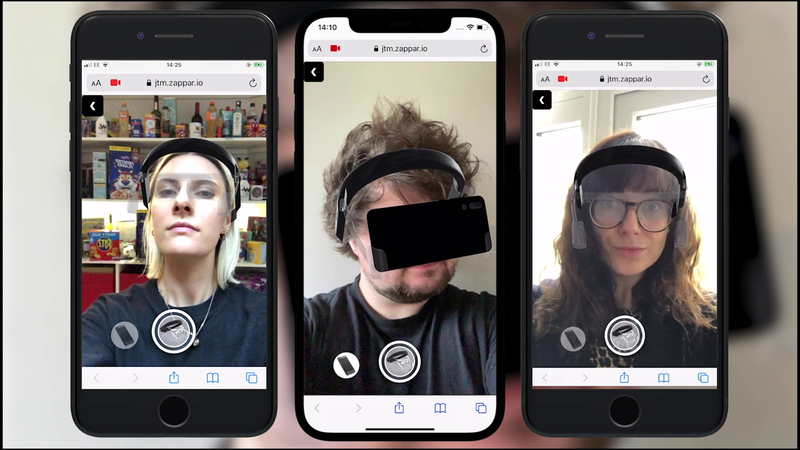2020 has been, to put it mildly, an unpredictable year that’s caused drastic changes to consumer behaviors and observable habits worldwide. Adopting new lifestyles (to keep the pandemic at bay) has massively altered the way in which we interact with one another and shop which has led to the acceptance of technological innovations in ways, and at a speed, that we’ve never seen before.
Who would have predicted that the (much-maligned) QR code would stage such an incredible comeback this year? Now you can’t enter any pub or public space without getting your phone out and scanning to order a drink or register your presence!
This big boost in using QR codes has accelerated the adoption of scanning generally, across every demographic, which has had a net positive effect on the propensity to use mobile devices (and cameras) to access information and experiences.
Similarly, the massive shift to M-commerce has accelerated interest in new ways to deliver product visualizations, virtual try-ons and contactless shopping experiences.
The launch of the iPhone 12 this year has also sparked further interest in AR. With Apple's LiDAR technology now sitting directly in iPhone's, designers and developers have even more possibilities and scope when creating complex AR experiences.
Top AR predictions for 2021
At this time of year, we (here at Zappar) get together and try to gauge what the next 12 months will bring to the augmented reality space. It’s fair to assume that the trends above (which we didn’t quite have mapped out on last year’s predictions list) will continue through 2021, and I think that we might see the following happen:
- WebAR will expand at pace with adoption from an increasing number of FMCG brands, making it easier than ever for people to access experiences;
- The greater adoption of QR codes will lead to more consumers using them more widely, further boosting the opportunities for WebAR.
- Always-on AR programs over one-off campaigns remains a key barrier in AR adoption, but with more brands understanding the benefit of adopting an ongoing camera strategy it will continue to become more mainstream through 2021;
- More and more connected products will feature AR capabilities so their usage will become a more commonplace behaviour.
- AR will play a more active role in enhancing the conference and training vertical (as more blended learning events combining physical and virtual offerings come to market).
- Retailers will further adopt a camera capability within their rewards and loyalty programs as well as use AR to deliver new experiential opportunities to entice customers in-store and deliver virtual product demonstrations.
- More sports and entertainment franchises will embrace AR to deliver fan engagement and offer new promotional (and sponsorship) models to their brand partners.
- We’ll see a growth in more location-based experiences as lockdown measures ease throughout 2021.
- The premium/luxury end of the market will start to deploy AR experiences more readily - given the introduction of 5G, volumetric capture, and WebAR for more refined and frictionless brand experiences.
- The developer community, capable of making compelling AR experiences, will expand rapidly through 2021 with the introduction of initiatives like our own Universal AR SDKs to enable more developers using Unity, three.js and A-frame, etc... to author and publish more AR experiences with the tools they already know.
2021 predictions for AR in Marketing
- WebAR will continue to be used further in many areas, including product visualisation and virtual try-on linked directly to purchase;
- Volumetric capture experiences will increasingly be used across marketing as the cost of production continues to fall.
- Brands will partner more with location-based experiences as lockdown measures ease through 2021;
- As QR code adoption was boosted during COVID, consumers are more likely to use them to activate AR experiences. In turn, brands will use them for more uses, and develop on-pack experiences that connect packaging together with integrated marketing campaigns;
- 5G will tie closely with AR experiences, with the proliferation of more devices entering the market in 2021 that can use the technology;
- All the elements of product visualisation, virtual try-ons, contactless shopping, fan engagement will stick. This is all due to relentless move to digital as a proportion of total sales;
2021 predictions for AR in Retail
- AR will be used more in M-commerce for product visualisations and try-on; Interactions with products having 3D/AR content showed a 94% higher conversion rate than for products without AR/3D (Shopify)
- AR and voice search will combine, as shoppers guide through virtual stores with their commands;
- AR experiences will be tied more to loyalty campaigns that can earn customers points, offers and prizes.
- AR will increasingly form part of the experiential context of visiting physical stores for product demonstrations, visualisations and appointment to visit events.
2021 predictions for AR in Packaging
- AR in packaging will be mostly pushed by large companies already aligning to adopt AR at scale, such as Nestle, RB, Unilever, and P&G. Brands will offer a range of functional and brand building experiences around provenance, sustainability, utility and brand purpose;
- The greater adoption of QR codes will lead to more consumers using them both at point of purchase and point of consumption in the home and on-the-go;
2021 predictions for AR in L&D
- Onboarding and training will remain popular uses of AR through 2021;
- Learning manuals and posters that can be updated digitally will increase in usage within B2B corporations;
- Enterprises will use AR for internal communications, communicating internal health and safety procedures;
- New forms of AR-enabled corporate presentations will enter the market as a paradigm shift away from PowerPoint.
2021 predictions for AR in Education
- Cost-effective hardware solutions such as Zapbox will be adopted by classrooms looking for new and innovative ways to approach learning and development at scale across the spectrum from K-12 and earlier to vocational learning. Bringing down the barrier to adoption through affordability and accessibility.
- Blended learning techniques that cater to the requirement for teaching both in the classroom and at-home settings will open up opportunities in AR.
- We’ll see more businesses providing full end-to-end solutions for schools around XR for software, hardware and most importantly content, delivered by subject matter experts that meet the requirements of the curriculum.
2021 predictions for AR hardware
- Key players such as Facebook, Snap, and Niantic will continue to innovate alongside updates from Apple and Google with continued investment driving more opportunities for the AR ecosystem
- As 5G adoption grows, so does the speed of delivery and complexity of AR experiences that can leverage the faster download speeds crucial for large live events and streamed content (when they return).
- Better cameras, processing power, battery life, sensors, network speed and browser capabilities will continue to increase the opportunity for spatial storytelling as the AR market continues to grow.
- Products like Zapbox are paving the way for greater adoption of Mixed Reality for the mass market as we await the shift over the next five to ten years from phones to eyewear.
Final thoughts
Hopefully, the macroeconomic climate will begin to deliver a bit more stability in the year ahead. 2020 has proved to us all that as a sector the AR landscape is incredibly adaptable and very good at providing innovative solutions to a whole host of unpredictable problems through spatial storytelling. Bring on 2021!
 Caspar Thykier
Caspar ThykierCo-Founder & CEO, Zappar
